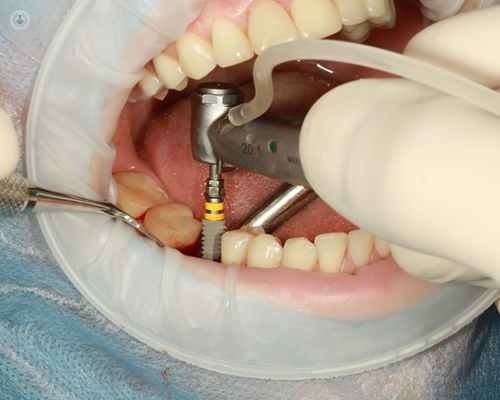Dental bone reconstruction: Building strong foundations for dental implants
Escrito por:If you've lost bone density, or a tooth, and are planning to have dental implants, you should be aware that you'll more than likely need a dental bone graft, or dental bone reconstruction.
But what’s involved? Here to offer an expert, detailed explanation is London-based dental surgeon Dr Koray Feran.

What does dental bone reconstruction entail?
When a tooth is lost, the bone is lost with it. So, the whole of the tooth-bearing part of the jaw is supported by the teeth, so the tooth bearer is supporting both of those. When a tooth is being replaced, the first thing that we want to do, is not lose the bone in the first place. If the tooth is being removed, clearly, we want to retain what bone there is around it, and not lose it. The idea is, is to maintain what's left. If it has been lost, due to bone infection or gum disease, you'll need to have sufficient bone volume.
The bone volume is for two things. First of all, we need bone volume to actually put the implants in. It doesn't need to be much, interestingly. You can get away with reasonably little bone and we use shorter implants, for example. More importantly that the actual support, is the long-term stability of the tissue around the implant. If you put an implant into too little bone, over time what tends to happen is that bone tends to remodel and get thinner. You also get recession around the implants, and the soft tissue follows the bone. You also end up with the implant becoming exposed or unsightly. The bone is there to support, but there needs to be enough of it so as not to shrink over time and it needs to be stable over time.
The bone augmentation is really to set the frame in which a tooth, or implant, will function over time. The more bone you have, the better the final results, the more stable the final result tends to be, and the more live bone there is around the implants, the better the implant will function. Bone augmentation is an integral part of virtually every implant. It's very rare that you get to place an implant into a site, and not add some level of bone - even if it's just a little bit.
Why might dental bone reconstruction be required?
If you don't have adequate bone for placing and implant, or for the shape of gum you require around the tooth so that it's natural, you need to augment the gum and the bone. So, it's not just the bone underneath, it's not just the bone health, it's also the soft tissue on top. When an implant goes in, it's not just about placing implants, it's also about making sure that there's a sufficient volume of bone around every dimension - it's three dimensional - and it also follows with the soft tissue on top. Otherwise, the implant won't look natural.
Who is the ideal candidate?
Anyone, as long as their medical history allows them to have surgery, and they aren't taking drugs that affect bone recovery. Then anyone can have bone augmentation. The bone augmentation can be carried out, (there are several different ways of doing it) but most people that require dental implants will require some level of bone augmentation.
How painful is it? What can patients expect after the operation?
During, it isn't painful at all. Afterwards, there's nothing much actually. Most people find there's not much difference in the level of discomfort you get for a tooth extraction.
It's quite gentle. It sounds pretty horrendous but actually it has to be gentle because you have to respect the tissues to get the best results. The idea is, you're creating volume. Very often, you're placing proprietary products into the bone housing, rather than having to go elsewhere on the patient. We're doing less and less procedures where we're having to take bone from the patient themselves - mostly it's fractured bone either from animals or prosthetics - that allows us to go ahead.
How long is recovery from dental bone reconstruction?
Recovery after the dental bone reconstruction surgery, just like any other surgery, will take a couple of weeks to fully heal so you're comfortable enough to function. But the bone itself will take anything from up to six months to a year, to mature fully. Bone heals slowly and one of the things that we mustn't underestimate is how long it takes to get a good, stable result. If you go in too early, if you try to put an implant into a graft too early, or if you try to load an implant too early that's been pressed and grafted into the bone, the level of failure will go up. So, you need to respect the fact that it will take up to six months to a year for a bone to fully mature.
If you’re considering dental bone reconstruction before having dental implants, arrange an appointment with leading London dental surgeon Dr Feran via his Top Doctors profile, today.


